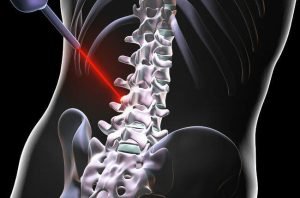
Minimally invasive spine surgery(MIS) is done to relieve the pressure being applied to the spinal nerves and to stabilize the spinal joints. The surgery is often a result of severe conditions such as bone spurs, herniated discs, scoliosis, or spinal tumors.
In traditional open surgery, the surgeon makes a long incision cut through the skin so that he can see the surgical site clearly. Similarly, to make your surgeon clearly examine the surgical area, a large amount of muscle and soft tissues are pulled out from the bone. That can result in pain after the surgery. Whereas minimally invasive spine surgery is faster, safer, and requires less time in recovery. In minimally invasive surgery, the surgeon makes more than one small incision or cut that is about 1/2 inches through the skin to continue the operation. Smaller incisions cause less damage to the muscles and soft tissues than a long cut.
Apart from that minimally invasive surgeries are performed using local anesthesia to reduce the risk factors for any unfavorable reaction.
Risks Associated With The Spine Surgery:
Every surgery involves some risks and complications. Even minimally invasive procedures.
Generally, spine surgery has these risks and complications:
- Excessive blood loss during the surgeries that require transfusion.
- Risk of Pneumonia.
- Reaction from anesthesia.
- Infection at the surgery site
- Blood clots in the legs often termed deep vein thrombosis that may pass to the lungs (pulmonary embolus).
- Spinal fluid leak
- Damage to the surrounding tissues
- Injury to the nerves or spinal cord can result in severe pain or even paralysis.
Also read: Scoliosis Spine Surgery Cost in India
Benefits of Minimally Invasive Surgery
There are several benefits of minimally invasive surgeries(MIS) as they only require small incisions or cuts which are possible because of the advanced instruments that allow surgeons to work without opening the whole abdomen or the area they are operating on.
- Some procedures like ovarian cyst removal, Ovarian cancer treatment, endometriosis treatment, or Hysterectomy can be done using robotics or minimally invasive techniques rather than any traditional open technique.
- Smaller incision causes less scarring because smaller incision requires only a few stitches that cause lesser scars. In any case, scaring due to the smaller incisions is less noticeable than a single long incision from traditional open surgery.
- Minimally invasive surgery procedures involve the usage of special cameras and advanced instruments. That helps in allowing the procedures to be done correctly and accurately. Hence, these surgeries are better and more accurate compared to open surgery.
- Patients who undergo minimally invasive procedures feel less pain and discomfort compared to those patients who have open surgery. Even serious complications like Blood loss are minimized when small incisions are used. Hence, a patient heals faster from MIS than open surgery.
- Patients who have minimally invasive surgeries have shorter stays in the hospitals than those who chose traditionally surgical procedures.
Know the Anterior Cervical Corpectomy Spine Surgery Cost in India
Common MIS Surgery Treatment Alternatives
 A number of specific techniques have been deployed for MIS surgery. Though the field continues to develop, the list below highlights some of the most common options.
A number of specific techniques have been deployed for MIS surgery. Though the field continues to develop, the list below highlights some of the most common options.
There are several techniques that can be used for MIS surgery.
- Discectomy Treatment: Spinal discs are elastic rings with soft material inside that act as cushions between the vertebral bones. In any case, if the elastic rings become weakened and the soft tissue gets extruded or herniated, then herniated material can compress the passing nerves and causes pain. To treat this, surgeons usually suggest a treatment to trim or remove the herniated disc, which is performed with a minimally invasive procedure that involves the use of a microscope or tubular dilators.
- Spinal decompression or Traction: It is a general term that is used to refer to several procedures that are intended to relieve the compression and pressure on the spinal cord and nerve roots.In spinal stenosis, the vertebral canal narrows down, resulting in a common condition that can lead to compression of the nerves. One can undergo a variety of symptoms like pain, numbness, and the weakening of muscles. Some common procedures included in decompression treatment are laminectomy and foraminotomy. Surgeons suggest surgery options in adverse conditions and procedures that might involve removing the bone and soft tissues. This is done through a minimally invasive surgery approach using tubular dilators and endoscopes.
- Transforaminal Lumbar Interbody Fusion: This minimally invasive surgery technique involves a procedure performed from the back posterior with the patient on his/her stomach. This procedure or technique is performed on patients who have a refractory mechanical low back and pain correlated with spondylolisthesis, degenerative disc diseases, and herniated disc. The whole procedure includes small incisions, rods, and screws that are placed between two or more vertebral levels. Then, the intervertebral disc is removed proceeding with the cage filling with bone and placing it in the void to stabilize the affected levels.
Post-Preparation Steps Before a Spine Surgery
- Exercise on regular terms to keep your muscles and body relaxed that can help you with easy recovery.
- Avoid Alcohol as much as possible. In case you are not able to do that, ask anyone for your help or you can take medications that can help you quit alcohol.
- Stop taking herbal remedies and non-essential medications. Make sure that you review all the products a few weeks before.
- Take help from your surgical team to guide you with proper knowledge and prerequisites.


